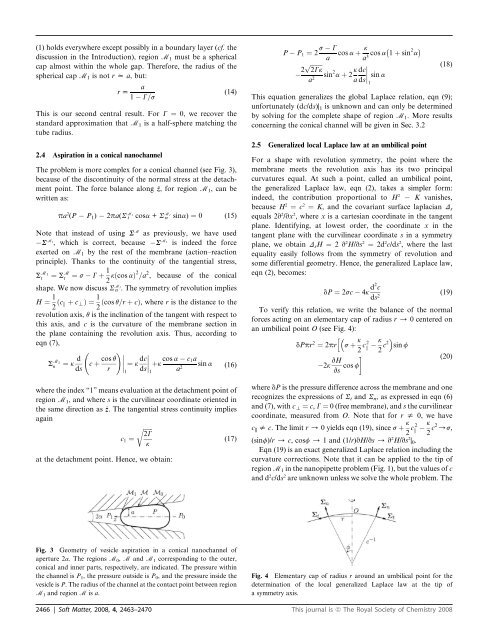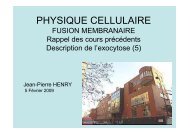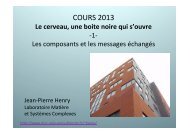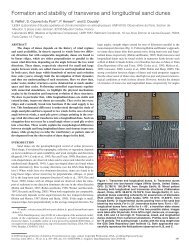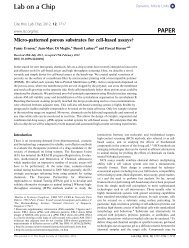PDF (361 K) - Laboratoire Matière et Systèmes Complexes - Paris 7
PDF (361 K) - Laboratoire Matière et Systèmes Complexes - Paris 7
PDF (361 K) - Laboratoire Matière et Systèmes Complexes - Paris 7
You also want an ePaper? Increase the reach of your titles
YUMPU automatically turns print PDFs into web optimized ePapers that Google loves.
(1) holds everywhere except possibly in a boundary layer (cf. the<br />
discussion in the Introduction), region M 1 must be a spherical<br />
cap almost within the whole gap. Therefore, the radius of the<br />
spherical cap M1 is not r x a, but:<br />
r x<br />
a<br />
1 G=s<br />
(14)<br />
This is our second central result. For G ¼ 0, we recover the<br />
standard approximation that M 1 is a half-sphere matching the<br />
tube radius.<br />
2.4 Aspiration in a conical nanochannel<br />
The problem is more complex for a conical channel (see Fig. 3),<br />
because of the discontinuity of the normal stress at the d<strong>et</strong>achment<br />
point. The force balance along ^z, for region M1, can be<br />
written as:<br />
pa 2 (P P1) 2pa(S M 1<br />
t cosa + S M 1<br />
n sina) ¼ 0 (15)<br />
Note that instead of using S M as previously, we have used<br />
S M 1 , which is correct, because S M 1 is indeed the force<br />
exerted on M1 by the rest of the membrane (action–reaction<br />
principle). Thanks to the continuity of the tangential stress,<br />
S M1<br />
t ¼ SM t<br />
¼ s G þ 1<br />
2 kðcos aÞ2 =a 2 , because of the conical<br />
shape. We now discuss S M 1<br />
n . The symm<strong>et</strong>ry of revolution implies<br />
H ¼ 1<br />
2 ðck þ ctÞ ¼ 1<br />
ðcos q=r þ cÞ, where r is the distance to the<br />
2<br />
revolution axis, q is the inclination of the tangent with respect to<br />
this axis, and c is the curvature of the membrane section in<br />
the plane containing the revolution axis. Thus, according to<br />
eqn (7),<br />
S M !<br />
d cos q<br />
1<br />
n ¼ k c þ ¼ k<br />
ds r 1<br />
dc cos a c1a<br />
þk<br />
ds 1 a2 sin a (16)<br />
where the index ‘‘1’’ means evaluation at the d<strong>et</strong>achment point of<br />
region M1, and where s is the curvilinear coordinate oriented in<br />
the same direction as ^z. The tangential stress continuity implies<br />
again<br />
rffiffiffiffiffiffi<br />
2G<br />
c1 ¼<br />
(17)<br />
k<br />
at the d<strong>et</strong>achment point. Hence, we obtain:<br />
Fig. 3 Geom<strong>et</strong>ry of vesicle aspiration in a conical nanochannel of<br />
aperture 2a. The regions M 0, M and M 1 corresponding to the outer,<br />
conical and inner parts, respectively, are indicated. The pressure within<br />
the channel is P 1, the pressure outside is P 0, and the pressure inside the<br />
vesicle is P. The radius of the channel at the contact point b<strong>et</strong>ween region<br />
M 1 and region M is a.<br />
s G<br />
P P1 ¼ 2 cos a þ<br />
a<br />
k<br />
a3 cos a 1 þ sin2a 2 ffiffiffiffiffiffiffiffi p<br />
2Gk<br />
a2 sin 2 a þ 2 k dc<br />
sin a<br />
a<br />
ds 1<br />
(18)<br />
This equation generalizes the global Laplace relation, eqn (9);<br />
unfortunately (dc/ds)|1 is unknown and can only be d<strong>et</strong>ermined<br />
by solving for the compl<strong>et</strong>e shape of region M1. More results<br />
concerning the conical channel will be given in Sec. 3.2<br />
2.5 Generalized local Laplace law at an umbilical point<br />
For a shape with revolution symm<strong>et</strong>ry, the point where the<br />
membrane me<strong>et</strong>s the revolution axis has its two principal<br />
curvatures equal. At such a point, called an umbilical point,<br />
the generalized Laplace law, eqn (2), takes a simpler form:<br />
indeed, the contribution proportional to H2 K vanishes,<br />
because H2 ¼ c2 ¼ K, and the covariant surface laplacian Ds<br />
equals 2v2 /vx2 , where x is a cartesian coordinate in the tangent<br />
plane. Identifying, at lowest order, the coordinate x in the<br />
tangent plane with the curvilinear coordinate s in a symm<strong>et</strong>ry<br />
plane, we obtain DsH ¼ 2 v2H/vs2 ¼ 2d2c/ds2 , where the last<br />
equality easily follows from the symm<strong>et</strong>ry of revolution and<br />
some differential geom<strong>et</strong>ry. Hence, the generalized Laplace law,<br />
eqn (2), becomes:<br />
dP ¼ 2sc 4k d2c ds2 (19)<br />
To verify this relation, we write the balance of the normal<br />
forces acting on an elementary cap of radius r / 0 centered on<br />
an umbilical point O (see Fig. 4):<br />
dPpr2 h<br />
¼ 2pr<br />
s þ k 2<br />
ck 2<br />
2k vH<br />
cos f<br />
vs<br />
k<br />
2 c2 sin f<br />
(20)<br />
where dP is the pressure difference across the membrane and one<br />
recognizes the expressions of St and Sn, as expressed in eqn (6)<br />
and (7), with ct ¼ c, G ¼ 0 (free membrane), and s the curvilinear<br />
coordinate, measured from O. Note that for r s 0, we have<br />
c|| s c. The limit r / 0 yields eqn (19), since s þ k<br />
2 c 2 k<br />
k<br />
2 c2 /s,<br />
(sinf)/r / c, cosf / 1 and (1/r)vH/vs / v 2 H/vs 2 |0.<br />
Eqn (19) is an exact generalized Laplace relation including the<br />
curvature corrections. Note that it can be applied to the tip of<br />
region M1 in the nanopip<strong>et</strong>te problem (Fig. 1), but the values of c<br />
and d 2 c/ds 2 are unknown unless we solve the whole problem. The<br />
Fig. 4 Elementary cap of radius r around an umbilical point for the<br />
d<strong>et</strong>ermination of the local generalized Laplace law at the tip of<br />
a symm<strong>et</strong>ry axis.<br />
2466 | Soft Matter, 2008, 4, 2463–2470 This journal is ª The Royal Soci<strong>et</strong>y of Chemistry 2008


